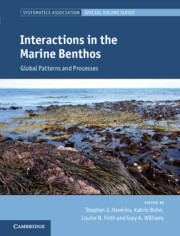Book contents
- Interactions in the Marine Benthos
- The Systematics Association Special Volume Series
- Interactions in the Marine Benthos
- Copyright page
- Contents
- Preface
- Contributors
- Chapter 1 Introduction
- Chapter 2 The Intertidal Zone of the North-East Atlantic Region
- Chapter 3 The Ecology of Rocky Subtidal Habitats of the North-East Atlantic
- Chapter 4 Rocky Intertidal Shores of the North-West Atlantic Ocean
- Chapter 5 Subtidal Rocky Shores of the North-West Atlantic Ocean
- Chapter 6 Shallow Water Muddy Sands of the North-West Atlantic Ocean
- Chapter 7 Biodiversity and Interactions on the Intertidal Rocky Shores of Argentina (South-West Atlantic)
- Chapter 8 Species Interactions and Regime Shifts in Intertidal and Subtidal Rocky Reefs of the Mediterranean Sea
- Chapter 9 The Restructuring of Levant Reefs by Aliens, Ocean Warming and Overfishing
- Chapter 10 North-East Pacific
- Chapter 11 The North-East Pacific
- Chapter 12 Consumer–Resource Interactions on an Environmental Mosaic
- Chapter 13 Where Three Oceans Meet
- Chapter 14 Rocky Shores of Mainland China, Taiwan and Hong Kong
- Chapter 15 Biogeographic Comparisons of Pattern and Process on Intertidal Rocky Reefs of New Zealand and South-Eastern Australia
- Chapter 16 The Past and Future Ecologies of Australasian Kelp Forests
- Chapter 17 Kropotkin’s Garden
- Chapter 18 Biofilms in Intertidal Habitats
- Chapter 19 Interactions in the Deep Sea
- Chapter 20 Overview and Synthesis
- Index
- Systematics Association Special Volumes
- References
Chapter 6 - Shallow Water Muddy Sands of the North-West Atlantic Ocean
Latitudinal Patterns in Interactions and Processes
Published online by Cambridge University Press: 07 September 2019
- Interactions in the Marine Benthos
- The Systematics Association Special Volume Series
- Interactions in the Marine Benthos
- Copyright page
- Contents
- Preface
- Contributors
- Chapter 1 Introduction
- Chapter 2 The Intertidal Zone of the North-East Atlantic Region
- Chapter 3 The Ecology of Rocky Subtidal Habitats of the North-East Atlantic
- Chapter 4 Rocky Intertidal Shores of the North-West Atlantic Ocean
- Chapter 5 Subtidal Rocky Shores of the North-West Atlantic Ocean
- Chapter 6 Shallow Water Muddy Sands of the North-West Atlantic Ocean
- Chapter 7 Biodiversity and Interactions on the Intertidal Rocky Shores of Argentina (South-West Atlantic)
- Chapter 8 Species Interactions and Regime Shifts in Intertidal and Subtidal Rocky Reefs of the Mediterranean Sea
- Chapter 9 The Restructuring of Levant Reefs by Aliens, Ocean Warming and Overfishing
- Chapter 10 North-East Pacific
- Chapter 11 The North-East Pacific
- Chapter 12 Consumer–Resource Interactions on an Environmental Mosaic
- Chapter 13 Where Three Oceans Meet
- Chapter 14 Rocky Shores of Mainland China, Taiwan and Hong Kong
- Chapter 15 Biogeographic Comparisons of Pattern and Process on Intertidal Rocky Reefs of New Zealand and South-Eastern Australia
- Chapter 16 The Past and Future Ecologies of Australasian Kelp Forests
- Chapter 17 Kropotkin’s Garden
- Chapter 18 Biofilms in Intertidal Habitats
- Chapter 19 Interactions in the Deep Sea
- Chapter 20 Overview and Synthesis
- Index
- Systematics Association Special Volumes
- References
Summary
We summarise processes determining large-scale patterns of distribution and abundance of macroinfauna from Florida to Newfoundland, ~25°N to 52°N, focussing on intertidal and shallow subtidal (~ 5 m depth) muddy sands and sandy muds, habitats with abundant experimental data. Within the theme of geographic distribution of processes, mechanisms and patterns we suggest latitudinal patterns will likely change most as climate changes intensify. Published studies support the following major biogeographic patterns: (1) reduced importance of large disturbance predators north of Cape Cod, driven by latitudinal shifts in thermal regimes; (2) large digging predators from Delaware Bay (39.25°N) southwards dramatically reduce infaunal densities, restricting competitive interactions; (3) disturbance refugia, e.g., Zostera, drive southern spatial patterns; (4) rising seawater temperatures and reduced water clarity limit the extent and diversity of rooted plants in the south and mid-Atlantic; (5) latitudinal changes in tidal regimes result in greater aerial exposure in the north, magnifying latitudinal sea surface temperature changes; (6) ice cover intensifies to the north and (7) the Boston−Washington, DC megalopolis accentuates human signatures through eutrophication between 36.5°N and 42.6°N. Finally, we discuss potential shifts with climate change in these latitudinal patterns and processes.
Keywords
- Type
- Chapter
- Information
- Interactions in the Marine BenthosGlobal Patterns and Processes, pp. 128 - 163Publisher: Cambridge University PressPrint publication year: 2019

